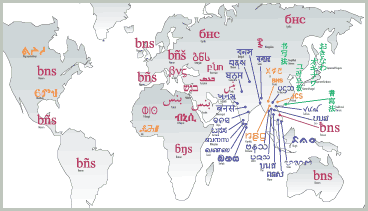
|
|
|||||||||||||||||||||||||
Beyond mere display, the accurate manipulation of language data is probably one of the greatest challenges we face in the 21st Century.
The Summer Institute of Linguistics (SIL) continues to research this problem.
Reordering
of Characters
In Roman text, characters generally appear in the order they are pronounced.
This is often not the case in other scripts. In the non-Roman example
below, characters are reordered, they change shape and are re-positioned.
|
Roman:
English |
|
Non-Roman:
Devanagari |
Characters
in Context
Roman characters have fairly consistent shapes when they are used. In
many other scripts, characters change their shape according to where they
appear.
|
Roman:
English |
|
Non-Roman:
Arabic |
Baseline
People who use writing systems based on the Roman alphabet learn to print
letters so they sit on a line. In other scripts, this isn't always the
case.
|
Roman:
English--Bottom Baseline |
|
Non-Roman:
Devanagari--Hanging Baseline |
 Graphite
technology enables computers to work with complicated fonts and
writing systems. More details, visit
Graphite
technology enables computers to work with complicated fonts and
writing systems. More details, visit 


